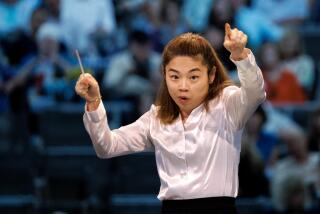Pianist’s Concert-Hall Music May Not Invite Biggest Following, but It’s a Hit With Critics
Their playing field is usually some out-of-the-way locale: a museum theater or a university hall. And you never see boldfaced newspaper ads for their concerts. No, crusaders in the field of modern music do not expect celebrity to beckon; they know they’ve opted for the dark cult corners of a largely esoteric idiom.
Imagine pianist Alan Feinberg’s surprise, then, to find himself the subject of a front-page photo story--in the London Times, no less, a year after his debut, in 1984.
“How it happened may have been understandable,” he says. “But it was still astonishing to see my picture there on Page 1.” The 42-year-old musician, who performs a program titled “The American Virtuoso” Monday night at the Los Angeles County Museum of Art, is known as a specialist in contemporary music. And he had made an astute discovery about the piece he was contracted to premiere in London: A sonata by Hungarian composer Laszlo Sary turned out to be a transposition of Charles Ives’ “Concord” Sonata.
“Note for note,” he says, “except that it was backward and upside down.”
Sary had not perpetrated a hoax, Feinberg says, “only a playful homage to Ives.”
Nevertheless, the pianist made his performance contingent on announcing the composer’s conceit to the audience. The press was alerted, and next day reported the news with a photo of Feinberg, Sary and the first page of the score.
The bearded Feinberg, who looks like a soft-edged Rasputin but who speaks with unusual modesty--even hesitation--says he is still amazed by certain other attention.
For instance, a review article that appeared three years ago in the Village Voice listed the names of Horszowski, Brendel, Pollini, Perahia and Feinberg. Feinberg ? How did he get on this roll of pianistic gods?
The fact is that critics everywhere rank him high, although Feinberg’s is not the kind of concert-hall music that invites the biggest following.
He doesn’t mind.
“A career made of playing the Top 40,” he says, referring to a standard repertory that spans Bach to Prokofiev, “does not offer the primary adventure or self-actualization I’m looking for. I would be just another pianist applying polish to the boot, or just another curator saying, ‘Come see my interpretations of your favorite works.’
“Instead, I’m saying, ‘Come in and sit down, I have something new to tell you.’ ”
A Brendel or a Pollini, he argues, draws audiences on his name value, never for the works played. The cult of the personality hardly exists, however, for Feinberg’s brand of endeavor.
Actually, he never had the laser-beam motivation common to most celebrated soloists and certainly never thought of himself as special.
“I was on my way to Harvard,” he explains, “but at the last minute, thought I wasn’t smart enough for that, so opted for Juilliard.”
But neither did he find a comfortable niche at the prestigious conservatory--a place overrun with Wunderkinder and competition-mongers.
Compared to them, he admits to being “undisciplined and not nearly at their advanced level.”
On the other hand, he says, the same traits saved him from the trauma that the “fast-track insiders,” as he calls them, experienced when vying for the virtuoso sweepstakes.
So how did this late bloomer ultimately earn the highest words of praise from such esteemed critics as Andrew Porter and Donal Henahan?
Quite serendipitously.
One day, he was asked to fill in for a concert of new music and made such a good impression that the group invited him to play regularly.
“It was my first encounter with contemporary music,” he says, “and my first sense of being a serious, professional musician with an actual stake in what transpired.”
Thus began what Feinberg calls his “real development,” a period in which he did all sorts of free-lance work--playing cabaret gigs and accompanying silent films such as “The Mark of Zorro” (1921), which was “a biggie,” he says with a laugh.
But he became a quick study and a versatile musician whose talent was becoming increasingly obvious. Through professional word of mouth, rather than hired hype, within a few years he was being offered solo platforms, and composers were writing music for him.
Ernest Fleischmann, executive director of the Los Angeles Philharmonic, and noted talent scout, happened to catch one of Feinberg’s performances in New York. “He was playing a Milton Babbitt piece,” Fleischmann recalls, “and I must say it was the first time I could make head or tail out of Babbitt, thanks to this pianist and his marvelous musical mind.”
Needless to say, Feinberg gets many invitations to play with the Philharmonic--as he does with other symphony orchestras.
Nor does he limit himself strictly to new music. Though his solo albums feature relatively unknown American composers, he revels in the occasional Gershwin, Thelonious Monk and, yes, Chopin, on his programs.
“How better to show off each composer’s stylistic profile than by putting it in a varied context? A whole program of Chopin becomes something precious and its own kind of ghetto.
“I guess what’s most important is to feel you own some part of the repertory--which is possible with unfamiliar music. No one owns Beethoven. But when Rachmaninoff walked on stage, everything about him said, ‘I own this piano, this music and for the next two hours, I own you.’ That had to be the ultimate self-realization.”
Alan Feinberg, in a concert titled “The American Virtuoso,” plays at 8 p.m. Monday at the Los Angeles County Museum of Art, 5905 Wilshire Blvd., Los Angeles. Tickets are $7 to $11. Call (213) 857-6010.
More to Read
The biggest entertainment stories
Get our big stories about Hollywood, film, television, music, arts, culture and more right in your inbox as soon as they publish.
You may occasionally receive promotional content from the Los Angeles Times.










